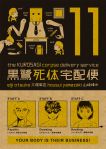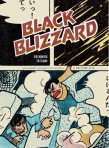Okay, I normally don’t dwell on this sort of thing, but I just have to make an observation about the covers in the DC section of the current Previews catalog. These are mostly the second issues of the publisher’s big re-launch of its super-hero line presumably to make it more accessible to people who wouldn’t normally pick up a comic about Superman or Batman or Green Lantern. Here’s my observation: the covers of these comics look exactly like these comics have looked for the last twenty years, possibly pinpoint-able right to the late 1990s. So this should be interesting, since it really does seem like an example of the scientific method. If all other things are equal, and DC changes one thing – the volume of back story in play to theoretically confuse or bar a casual reader from entry – will people who did not previously care about the Justice League suddenly start caring about the justice league? Time will tell! Let’s move on to things I will actually purchase!
Princess Knight vol. 1, written and illustrated by Osamu Tezuka, Vertical, Inc., AUG11 1232: The most actually exciting thing in the catalog is the English-language debut of Tezuka’s game-changing shôjo classic. Some of us have been waiting years for this to happen. Years.
Hark! A Vagrant, written and illustrated by Kate Beaton, Drawn & Quarterly, AUG11 1018: Beaton’s super-smart comics “takes readers on a romp through history and literature — with dignity for few and cookies for all — with comic strips about famous authors, their characters, and political and historical figures, all drawn in Beaton’s pared-down, excitable style. This collection features favourite stories as well as new, previously unpublished content. Whether she’s writing about Nikola Tesla, Napoleon, or Nancy Drew, Beaton brings a refined sense of the absurd to every situation.”
Two Generals, written and illustrated by Scott Chantler, Emblem Editions, AUG11 1060: This is the soft-cover edition of Chantler’s acclaimed historical graphic novel.
Tesoro: Short Stories 1998-2008, written and illustrated by Natsume Ono, Viz Media, AUG11 1256: This volume collections some of the earliest professional work by the gifted creator of series like Gente and The House of Five Leaves. So you should probably buy it.
There’s also the 2011 edition of The Best American Comics from Houghton Mifflin. I’ve made it this long without reading one of these, so I doubt my streak will be broken, though the guest editorial duties of Alison Bechdel may make me waver.
And here are new volumes of ongoing series that you should seriously consider buying:
- Wandering Son vol. 2, written and illustrated by Takako Shimura, Fantagraphics, AUG11 1048
- Sayonara, Zetsubou-Sensei vol. 11, written and illustrated by Koji Kumeta, Kodansha Comics, AUG11 1107
- Salvatore vol. 2: An Eventful Crossing, written and illustrated by Nicholas De Crécy, NBM, AUG11 1134
- Chi’s Sweet Home vol. 7, written and illustrated by Kanata Konai, Vertical, Inc., AUG11 1233
- Twin Spica vol. 10, written and illustrated by Kou Yaginuma, Vertical, Inc., AUG11 1234
- Kimi ni Todoke: From Me to You vol. 11, written and illustrated by Karuho Shiina, Viz Media, AUG11 1245
- The Story of Saiunkoku vol. 5, by Kairi Yura and Sai Yukino, Viz Media, AUG11 1247
- Real vol. 10, written and illustrated by Takehiko Inoue, Viz Media, AUG11 1255
- A Bride’s Story vol. 2, written and illustrated by Kaoru Mori, Yen Press, AUG11 1266
- Yotsuba&! vol. 10, written and illustrated by Kiyohiko Azuma, Yen Press, AUG11 1274
That’s… like… a lot.





 Ayako
Ayako















